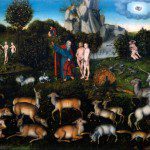I am slowly working through a series looking at the impact that the evidence for evolution has on our theology. This series is based on a book of essays, Theology After Darwin (available from amazon UK or, as pointed out by a commenter, a search of Abebooks.com on author = Berry and title = Theology After Darwin will yield a USA-based source for a new copy of the book at a reasonable price (HT PB)). The question posed to the authors is quite simple, What are the implications for Christian theology if Darwin was right?
 Nowhere do we find the question more central to our faith than in the subject of the essay by Francisco J. Ayala: Being Human After Darwin. David Fergusson, at the end of the chapter we discussed in the last Tuesday, suggested that a biblical understanding of human significance is challenged, perhaps, by the theory of evolution and common descent. If mankind is not the pinnacle and purpose of all creation, what are we? If we evolved in continuity with the animals what makes humans distinctive creatures? He commented briefly on the issue, but Dr. Ayala’s essay centers in on this question.
Nowhere do we find the question more central to our faith than in the subject of the essay by Francisco J. Ayala: Being Human After Darwin. David Fergusson, at the end of the chapter we discussed in the last Tuesday, suggested that a biblical understanding of human significance is challenged, perhaps, by the theory of evolution and common descent. If mankind is not the pinnacle and purpose of all creation, what are we? If we evolved in continuity with the animals what makes humans distinctive creatures? He commented briefly on the issue, but Dr. Ayala’s essay centers in on this question.
Francisco Ayala is the Donald Bren Professor of Biological Sciences, a University Professor, a Professor of Philosophy, and a Professor of Logic and the Philosophy of Science at the University of California, Irvine. He is a member of the National Academy of Sciences elected in 1980 and cited for his work in evolutionary biology. His research expertise is listed on the NAS website as evolution, genetics, population biology, origin of species, malaria, parasitic protozoa, and epidemiology. In more recent years he has also been active in the philosophy of science and the interaction between science and faith. In his essay on what it means to be human Dr. Ayala first presents a brief survey of the state of knowledge on human origins and then considers specifically the egg-to-adult transformation, the brain-to-mind transformation, and the ape-to-human transformation.
Mankind is a biological species that has evolved from other species that were not human. In order to understand human nature, we must know our biological make-up and whence we come, the story of our humble beginnings. (p. 89)
The three transformations above, says Dr. Ayala, “define the humanum, that which makes us specifically human.” He suggests that a consideration of these transformations “provide[s] a valid foundation for a religious view of humans as special creatures of God.” (p. 90)
Human Origins. In the opening section on human origins Dr. Ayala outlines how traditional studies of origins, that is studies in the fields of paleontology, biogeography, and comparative biology (consideration of similarity and difference in morphology, development, physiology and such), have been enhanced and informed by the addition of molecular biology to the researcher’s tool box. Molecular biology, specifically genetics and the study of genomes, brings a level of precision and control to the study of ancestral relationships that is simply not possible from the other disciplines alone. But, and this is an important point, all of these sources of information come together to build a coherent picture with explanatory power.
The Missing Link. One of the common objections to common descent is the so-called missing link. This was a serious consideration in the nineteenth century when Darwin published his books On the Origin Of Species and The Descent of Man. While there are still gaps and questions, much has been learned and fossil remnants of many intermediate forms have been found and studied. The Cradle of Humankind in South Africa has been particularly fruitful for study. The hominid lineage diverged from the chimpanzee lineage some 7-8 million years ago. Dr. Ayala gives a brief sketch of this fossil record as it is currently known and understood. Homo erectus appeared on the scene somewhat before 1.8 million years ago. Many of the fossil species are thought to be co-lateral rather than in direct line of descent for modern humans. Bottom line – many intermediate form fossils have been identified. You can dismiss common descent, but such dismissal cannot be based on the absence of fossil support for the proposal. There is support and it is growing as more fossils are unearthed and studied.
The data is not only in the fossil record but is embedded in each of us living today as well. DNA analysis of modern humans confirm the fossil evidence and points to an African origin for humankind. Modern humans appeared on the scene something like 150,000 years ago.
Analyses of DNA from living humans has confirmed the African origin of modern H. sapiens, which is dated by these analyses at about 156,000 years ago in tropical Africa. The DNA estimates of ancestral dates however, have broad ranges of possible variation (the so-called 95% ‘confidence interval’). The estimated origin of modern humans based on these DNA investigations is more appropriately given as 100,000-200,000 years ago. (94)
There may have been a bottleneck in the development of modern humans in Africa with the initial population consisting of something between 10,000 and 100,000 individuals, but there was a community within which the changes occurred.
The Genetic Evidence. Dr. Ayala does not go into the evidence for common descent found embedded in the human genome revealed by molecular biology and comparative genomics. Both Francis Collins in The Language of God and Darrel Falk in Coming to Peace With Science present more of the evidence. I discussed some of this in a post entitled “At Peace With Science?” two years ago (and reproduce some of it below). Two very good lectures on Human Evolution by Professor Darrel R. Falk from 2008 are also available from The Faraday Institute for Science and Religion (you can download in mp3 format – just search on Falk or Evolution). One lecture was part of a summer course for scientists while the other lecture was for an audience comprised primarily of church leaders.
So what is the evidence? There are a multitude of lines – each convincing in its own right, but together irrefutable. Dr. Falk highlights three strands of evidence, Alu sequences, Human Chromosome 2, and synonymous and nonsynonymous mutations. Dr. Collins in highlights Human Chromosome 2, ancient repetitive elements (AREs), nonfunctional pseudogenes such as caspase 12, and the functional mutation of the FOXP2 gene…but these six examples are only the tip of the iceberg.
Chromosome 2 is a fascinating story – apes have 24 pairs of chromosomes while humans have 23. This is, of course, a significant deviation and something that could derail the hypothesis of common descent. Humans could not have withstood the loss of an entire chromosome in the process of evolution and apes could not have evolved an additional chromosome that quickly. But human Chromosome 2 has clear evidence of fusion resulting from the head-to-head connection of two of the chromosomes found in chimpanzees and other apes; at some point in our development two chromosomes became one. This fusion is marked by the presence of residual telomeres (end caps) within the fused human chromosome and by the presence of an inactive residual centromere in the exact location where it is found in the separate chromosome of the chimpanzee.
The presence of the unnecessary residual telomere and centromere within chromosome 2 is one strong thread of the evidence for common descent – humans and chimps evolving from a common ancestor with chromosome fusion occurring on the branch leading to humans but not on the branch leading to chimps. Why would God create man from dust as a unique creature, give us one less chromosome, and introduce an unnecessary and unused telomere and centromere into chromosome 2?
The caspase 12 pseudogene provides us a similar example. This gene is found in the same location in both chimps and humans – it is functional in chimps, but nonfunctional, having suffered a knockout mutation in humans.
Molecular support of this type could fill thousands of pages…and has convinced virtually all working biologists, biochemists, and scientists of all stripes, that the general scheme of evolution including common descent is unquestionably correct. This is a jigsaw puzzle where the pieces fit beautifully within the framework of evolutionary theory. The only reason to doubt the general framework is a presupposition that it is not true.
While one could argue that natural mechanism alone is insufficient to produce what we see today, evolution by some mechanism is as nearly proven fact as anything in biology can be.
But what makes us human? All of this is incidental or background to the real thrust of the question Dr. Ayala addresses in his essay though. The three transformations, egg-to-adult, the brain-to-mind, and the ape-to-human transformations define important features of our history that serve to make us human. This will be the subject of my next post on his essay.
For now I return to the original question.
What do you think? What are the implications for Christian theology if Darwin was right?
If you wish to contact me directly you may do so at rjs4mail[at]att.net
You can subscribe to a full text feed of my posts at Musings on Science and Theology.












